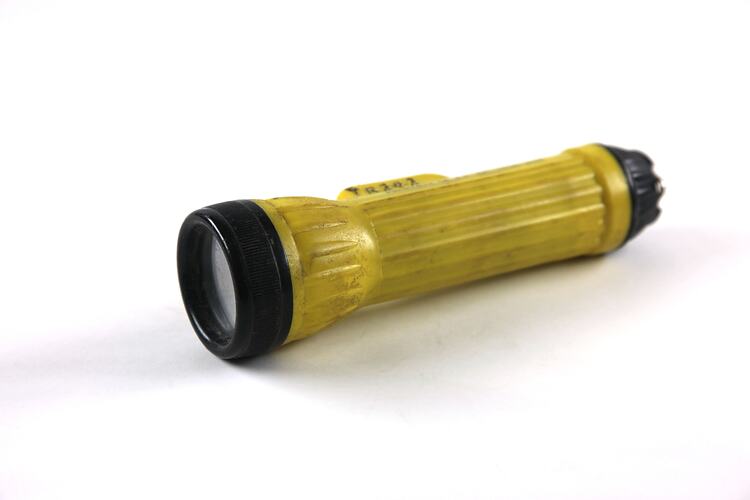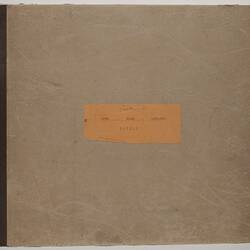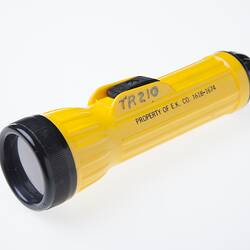Summary
An interesting and unusual job at Kodak was that of the safelight serviceman. His role was to ensure that people could work safely in the darkened environment required by the photographic industry.
An interesting and unusual job at Kodak was that of the safelight serviceman. His role was to ensure that people could work safely in the darkened environment required by the photographic industry.
The manufacture of photographic plates, film and contact papers involved coating the base material with light-sensitive silver halide emulsions, so it was essential that light be excluded during the process. If unexposed film came in contact with light before it was used in the camera, it could be spoilt. Similarly, it was essential that the development of photographs from exposed film be free from light contamination. People working in manufacturing and developing at Kodak were therefore required to work in darkness. However an environment of total darkness was impractical and unsafe for workers, so special lighting, known as safe lighting, was necessary. The term 'safe lighting' actually referred to the type of lighting to which film products could be safely exposed.
Safelights, developed in the early days of photography by the English photography firm Wratten and Wainwright, involved the use of coloured filters to screen the lights used in darkrooms. The name Wratten continued to be associated with safelights and filters after the firm was taken over by Eastman Kodak in 1912 [Collins pp 116-7].
Kodak manufactured a large range of film products, including black and white glass plates and roll film, colour film for slides and prints, contact papers, x-ray film and light-sensitive materials used in the graphic industry and business imaging systems. Each type of light-sensitive product had a low sensitivity to different colours in the spectrum. For example the orthochromatic emulsions used in black and white film were less sensitive to the red end of the spectrum, while the panchromatic range of colour products was less sensitive to colours at the green end of the spectrum.
The creation of the appropriate safe-lighting for each photographic product required an understanding of light and its interaction with chemicals. Kodak developed a set of spectrophotometric graphs as a basis for working out which colour light each type of product could tolerate during manufacture, storing and developing.
Brian Phillipson, who worked as a safe lighting technician for Kodak Australasia for 22 years remembers the red, green and amber safelights at Kodak's Abbotsford and Coburg plants. The OA1 safelight filter, used in the manufacturing environment for black and white photographic papers, was made by sandwiching bond paper between two glass plates, one coated with yellow dye, the other with amber dye. Green filters were used for Kodachrome, the film used for colour slides.
Other factors taken into account in safe lighting technology were light intensity and direction, plus the length of time a product could be exposed to light.
Safelight technicians worked in conjunction with electricians and electrical engineers to lower the intensity of ordinary light globes, so that low wattage globes could be run at reduced voltages. Technicians also experimented to determine how long a product could be exposed to light. They ran 'fogging checks' by exposing several test strips of sensitised material to safelights. Each strip was exposed for a different period of time, from 15 seconds up to four minutes. When the strips were developed the strip that showed an image after the shortest exposure indicated the time limit for exposing the particular product to the safelight.
Safelights were placed at strategic points in the factory, store or darkroom so that they did not shine directly onto the products. Some lights were placed under benches, others were on the floor. Much of the technology was developed by trial and error, improvising as technicians addressed each task. Brian Phillipson describes some of the improvisations used by Kodak's safe lighting team: 'We got LEDs and we made circuit-boards with a trimming pot on them to lower the intensity of the light, and made them into aluminium housings for under bench lights. You could have more light intensity under a bench or on a floor because you weren't getting the intensity on the top where the product was. You could still see what you were doing, because it was reflective light. We ended up developing metal boxes on the floor in production and storage areas. They were aluminium boxes with a filter in them, and some of them had a 12 volt 30 watt aircraft landing light in them. We'd run them at 6 volts. An aircraft landing light was very orientated, a narrow beam, so we'd put white tape on the floor and that beam would go in front of the aircraft landing light, with a louvre so it'd train the light to the floor. You could see about 30 feet. We'd have one at each end so you could walk up and down, or come into the aisles, and you could walk in onto these white strips and pick up what you wanted. Plus you'd have a safe light torch, I'd make filters for them. Then, of course, if there's no product in that area where people had to move around, you could tolerate brighter lighting. The closer you got to the product, the more sensitive it become.'
Each part of the Kodak factory had a safe lighting plan and the safe lighting team documented every safe light on the factory floor plan. Members of the safe lighting team were even responsible for changing the light globes in dark areas. As Brian Phillipson points out, they were specialists who had developed their own expertise: 'People used to think we were just globe jockeys. No way.We were there because it had to have the right globe. Put the wrong globe in, you're in big trouble. It's all in-house, you've got no certificates or diplomas or anything like that, it's all self applied. Safelight serviceman, that's what they called us.'
References
Collins, Douglas, The Story of Kodak, Harry N. Abrams, New York, 1990.
Brian Phillipson interviewed by Lesley Alves, 8 January 2014
More Information
-
Keywords
-
Authors
-
Article types






